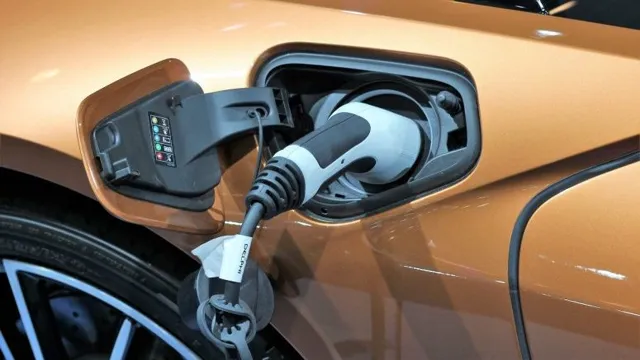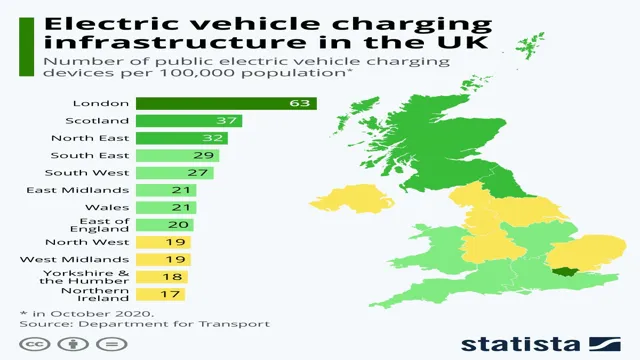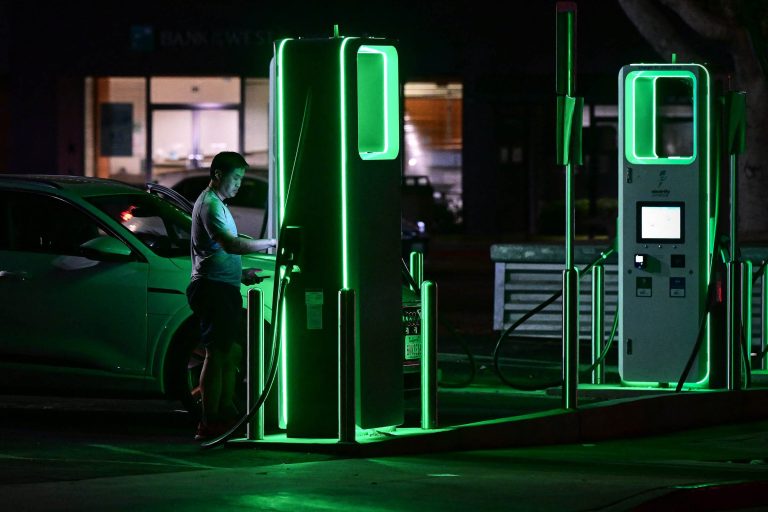Powering up: An Electric Outlook on the Future of Car Charging Infrastructure
Electric cars are becoming increasingly popular as an environmentally friendly alternative to traditional gas-powered vehicles. But with this shift in transportation comes the need for a robust charging infrastructure. As more and more electric cars hit the roads, the demand for charging stations will skyrocket.
So, what can we expect for the future of electric car charging infrastructure? Let’s take a closer look at the forecasts and trends. With advancements in technology and increased investment in charging infrastructure, we may see a charging ecosystem that rivals gas stations in the near future. But how will this shift affect our daily lives and the transportation industry as a whole? Join us as we explore the exciting and rapidly evolving world of electric car charging infrastructure.
Current Electric Vehicle Sales Trends
The sales of electric vehicles are skyrocketing, which means that the demand for electric car charging infrastructure is growing equally fast. The most important factor for EV sales growth is the availability of the required charging infrastructure. With more charging stations being built across the world, it is predicted that the global electric car charging infrastructure market will grow at a CAGR of over 32% by 202
Governments are also giving out incentives for the installation of more charging stations, which is causing the industry to grow at an unprecedented rate. All of this means that the next few years will be crucial for the development of electric vehicle charging infrastructure. The future of EVs is extremely bright, and we can expect more and more people to make the switch to electric vehicles in the near future.
Data on global sales of electric vehicles by year
Electric vehicle sales have been on the rise globally in recent years, with major car manufacturers investing heavily in this market. According to the International Energy Agency, the number of electric vehicles sold worldwide in 2020 reached 1 million, a 41% increase compared to the previous year.
Additionally, countries such as China and Europe have set ambitious targets for electric vehicle sales in the coming years, making it clear that this trend is here to stay. With the increasing awareness of the impact of fossil fuels on the environment and the availability of financial incentives for environmentally friendly vehicles, electric cars are becoming more accessible and appealing to consumers. As the world transitions to more sustainable forms of energy, the growth in electric vehicle sales is expected to continue in the coming years.
Growth rate comparison of electric vehicles vs. traditional vehicles
When it comes to electric vehicle (EV) sales, there has been a significant increase in recent years. In fact, the growth rate of EVs is several times higher compared to traditional vehicles. This trend indicates a growing interest and demand for cleaner and more sustainable modes of transportation.
While traditional vehicles still hold the majority of the market share, EVs are rapidly gaining ground. The convenience and cost-effectiveness of EVs are contributing factors in their rising popularity, and they are also becoming more widely available. It’s no surprise that this shift towards eco-friendly vehicles is here to stay.
As more people become aware of the environmental impact of transportation, the growth rate of electric vehicles sales is set to continue at an incredible pace.
Charging Infrastructure Investments
Electric car charging infrastructure forecast shows a bright future for the electric vehicle industry. With more and more people shifting from conventional gasoline vehicles to electric cars, the demand for charging stations is increasing. Investments in charging infrastructure are crucial to the growth and success of the electric vehicle market.
Governments, car manufacturers, and private companies are investing heavily in building a vast network of charging stations that offer fast and convenient charging options. The rising demand for electric cars is set to create a surge in charging infrastructure investments, and it’s estimated that the industry will reach $84 billion by 2030. This investment will drive innovation and the adoption of new technologies, making electric cars more accessible and affordable for the masses.
As the electric car market expands, and more people switch to environmentally friendly cars, charging infrastructure investment will become increasingly important.
Data on current and projected investments in electric vehicle charging infrastructure
If you have been following the electric vehicle market closely, you may have wondered about the current and projected investments in charging infrastructure. Well, let me tell you that the numbers are quite impressive. According to a report, the global market for EV charging infrastructure is expected to reach almost $100 billion by 2030.
In fact, in 2020 alone, there was a whopping $9 billion investment in charging infrastructure globally. What’s more, many countries, including China, the US, and the UK, have set ambitious targets for the deployment of chargers.
For instance, the UK government aims to install 60,000 new public charging points by 2030, while China has more than 1 million charging points currently in operation. As demand for EVs continues to rise, you can expect to see significant investments in charging infrastructure from governments, automakers, and private companies.
Comparison of investment trends by region
When it comes to charging infrastructure investments, there are regional differences worth noting. In North America, the United States leads the way in terms of investment. In fact, the Biden administration’s proposed infrastructure plan includes a $15 billion investment in charging stations.
Europe is not far behind, with many countries like Norway, Sweden, and the Netherlands having already made significant strides in electrification. China, on the other hand, has been leading the way in electric vehicle adoption, with a heavy investment in charging infrastructure to match. While some developing regions like Africa and Latin America still have a long way to go in terms of electrification and charging infrastructure, they also have an opportunity to leapfrog older technologies and implement modern solutions from the start.
Overall, the trend towards charging infrastructure investments is encouraging, and a sign that the shift towards electric mobility is gaining momentum.
Impact of government incentives and regulations on infrastructure investments
Charging infrastructure investments play a critical role in the wider adoption of electric vehicles (EVs) and the transition to clean energy. Public and private investments in building charging infrastructure have been slow, but there are governments’ initiatives designed to encourage EV charging networks’ development. For example, some nations offer tax credits and rebates for charging station installations and provide grants and low-interest financing options to EV charging infrastructure providers.
These incentives lower the costs of charging station development, which makes it more attractive to utility companies and private investors. Government regulations setting standards for charging station types, locations, and accessibility also impact EV charging infrastructure investment. Governments around the world are taking steps to standardize and regulate charging stations, making it easier for EV drivers to find charging stations and build charging infrastructure.
This shift helps facilitate the integration of EVs into existing transport infrastructure and accelerate the transition to cleaner energy.
Forecasts for Electric Vehicle Charging Infrastructure
According to recent reports, the electric car charging infrastructure forecast is looking incredibly promising. In fact, it is predicted that the market will grow at a CAGR of over 32% from 2021 to 202 This is due to factors such as the increasing demand for electric vehicles, government initiatives promoting the adoption of EVs, and the construction of new charging stations.
Furthermore, the development of advanced technologies like wireless charging and smart charging systems is expected to drive the market even further. As the popularity of electric vehicles continues to rise, it is clear that the demand for electric car charging infrastructure will only continue to grow. With this in mind, companies that specialize in EV charging infrastructure are likely to experience significant growth in the coming years.
The future of electric vehicle charging infrastructure is bright, and it’s exciting to think about the possibilities that lie ahead.
Projection for number of charging stations globally by year
Electric Vehicle Charging Infrastructure As the world becomes more reliant on electric vehicles, the demand for charging stations skyrockets. Experts predict that the global number of charging stations will reach 30.7 million by 2030.
This increase in infrastructure is crucial for EV owners, who need reliable and accessible charging options. Government incentives and regulations push automakers to develop electric vehicle technology, which drives the need for more charging stations. Moreover, the growth of ride-sharing and autonomous vehicles gives more opportunities for EV charging demand.
Consumers want the confidence that they can charge their vehicles wherever they go. Therefore, investing in more charging stations is essential for EV’s proliferation. Although we have a long way to go, the future of electric vehicle charging infrastructure looks promising.
Forecast for types and locations of charging stations in different regions
When it comes to forecasting the growth and expansion of electric vehicle charging infrastructure, there are a number of factors to consider. One key consideration is the region in question, as different areas of the world have different needs and preferences when it comes to EV charging. For example, in cities with dense populations and limited space, it may be necessary to focus on building more fast-charging stations that can quickly recharge EVs and keep them on the road.
In more rural areas, on the other hand, slower charging stations that can keep EVs powered up over longer periods of time may be more practical and effective. Additionally, we can expect to see more charging stations incorporated into existing infrastructure, such as parking garages, rest stops, and major highways. Overall, by identifying the specific needs of different regions and tailoring charging infrastructure accordingly, we can help to ensure that EVs become a viable and accessible option for more and more drivers around the world.
Future Implications for Electric Car Charging Infrastructure
As the demand for electric cars continues to rise, there is a growing need for a robust electric car charging infrastructure that can keep up with the pace. Many experts predict that the market for electric car charging infrastructure will experience exponential growth in the coming years. It is estimated that the global market for electric car charging infrastructure will reach $56 billion by 2029 and will rise to $146 billion by 203
This forecast is promising for electric car owners as it signals an increased availability of charging stations. However, it also presents challenges for service providers to keep up with the rapid pace of development and address the growing demand for charging points. The industry is expected to evolve as technology advances, requiring providers to keep pace with the new technological changes.
There is also a need for standardization of charging infrastructure to ensure compatibility and convenience for electric car owners. As such, it is critical that players in the industry stay ahead of trends and focus on innovation to cater to the needs of the growing number of electric car owners.
Conclusion
In conclusion, the future of electric car charging infrastructure is electrifying! With advancements in technology, the convenience of charging at home, and an increase in public charging stations, the road towards sustainable transportation is becoming more accessible every day. So let’s plug in and charge on towards a greener future!”
FAQs
What is the current status of electric car charging infrastructure in the United States?
As of 2021, the United States has over 100,000 public electric car charging stations available for use.
Will there be an increase in the number of electric car charging stations in the coming years?
Yes, according to industry experts, the number of public electric car charging stations in the United States is expected to grow to over 500,000 by 2030.
What factors are driving the growth of electric car charging infrastructure?
The growth of electric car charging infrastructure is being driven by government incentives, renewable energy mandates, and increased consumer demand for electric vehicles.
What are the different types of electric car charging stations?
There are three main types of electric car charging stations: Level 1 chargers (which use a standard 120-volt household outlet), Level 2 chargers (which use a 240-volt outlet and can charge a car faster), and DC fast chargers (which can charge a car to 80% capacity in 30 minutes or less).





